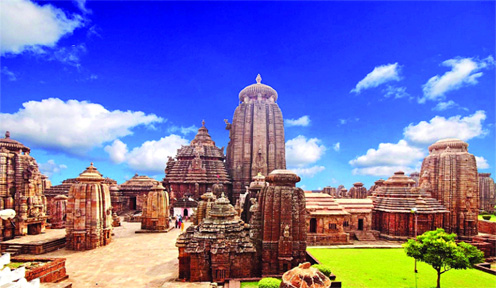
Bhubaneswar, famously known as the Temple City of India, is a harmonious blend of ancient heritage and modern urbanization. Located in Odisha, Bhubaneswar’s unique identity stems from its status as a repository of Indian temple architecture, cultural traditions, and its rapid transformation into a smart city. As the chosen venue for the 18th Pravasi Bharatiya Divas (PBD) in January 2025, the city will once again be in the global spotlight, showcasing its historical, cultural, and economic vibrancy.This article explores Bhubaneswar’s rich legacy, its evolution into a modern city, and its significance as the host of the Pravasi Bharatiya Divas, a global event that celebrates the Indian diaspora’s contributions.
The Temple City’s Heritage
Bhubaneswar derives its name from “Tribhubaneswar,” meaning “Lord of the Three Worlds,” referring to Lord Shiva. The city is home to over 700 temples, many of which date back to the 7th and 13th centuries, exemplifying the Kalinga architectural style.Lingaraj Temple: A masterpiece of Kalinga architecture, the Lingaraj Temple is dedicated to Lord Shiva and is a prominent pilgrimage site.
The city’s temples are not just religious centers but also repositories of art, culture, and history. They attract historians, architects, and tourists from across the globe.
Cultural Significance
Bhubaneswar is more than just its temples. It is a cultural hub where traditional art forms like Odissi dance, Pattachitra painting, and stone carving thrive. The city also serves as a gateway to Odisha’s vibrant festivals such as Rath Yatra, Durga Puja, and Ekamra Utsav, which celebrate the region’s spiritual and artistic traditions.
Bhubaneswar: The Cultural and Architectural Marvel of India
Bhubaneswar, the capital city of Odisha, is a treasure trove of culture, architecture, and heritage. Known as the “City of Temples,” it boasts a history that spans over 3,000 years. From its ancient temples to modern urban planning, Bhubaneswar is a city that seamlessly blends its glorious past with a progressive present.
Historical Significance of Bhubaneswar
Bhubaneswar derives its name from the Sanskrit words “Bhubaneswar”, meaning “Lord of the Universe.” It is believed to have been the seat of the powerful Kalinga kingdom, which played a crucial role in shaping the history of ancient India.
The city’s historical roots can be traced to the 2nd century BCE, as evidenced by the archaeological remains at Sisupalgarh, one of the oldest known fortified urban centers in India.The turning point in Bhubaneswar’s history was the Kalinga War (261 BCE), fought near the city’s vicinity. This transformative event led to Emperor Ashoka’s conversion to Buddhism and the spread of Buddhist teachings across Asia.
Bhubaneswar’s historical narrative is deeply intertwined with Hinduism, Buddhism, and Jainism, making it a confluence of diverse religious traditions.
Cultural Vibrance
Bhubaneswar is not just a city but a living museum of Odisha’s vibrant culture. The city is renowned for its festivals, dance forms, music, and crafts, which reflect the ethos and spirit of Odisha.FestivalsThe festivals of Bhubaneswar are a testament to its cultural richness.
The city comes alive during Rath Yatra, a grand chariot festival dedicated to Lord Jagannath. Though the primary celebrations occur in Puri, Bhubaneswar’s temples also partake in the festivities. Durga Puja, Makar Sankranti, and Diwali are celebrated with great enthusiasm, showcasing the city’s communal harmony.The Ekamra Utsav, a cultural festival named after Bhubaneswar’s ancient name, Ekamra Kshetra, highlights the city’s artistic heritage. It features traditional music, dance performances, and exhibitions of local crafts, drawing visitors from across the globe.
Dance and Music
Odissi, one of India’s classical dance forms, originated in Odisha and finds its soul in Bhubaneswar. The city is home to iconic institutions like the Odissi Research Centre, where the dance form is preserved and propagated. The fluid movements, intricate gestures, and emotive expressions of Odissi are a visual delight, embodying the spiritual essence of the city.
Music in Bhubaneswar ranges from classical Odissi music to contemporary forms. The city’s musicians have preserved traditional instruments like the mardala and the gini, which add a unique rhythm to its musical heritage.
Handicrafts and Textiles
Bhubaneswar is a hub for Odisha’s famous handicrafts and textiles. The city markets, such as Ekamra Haat, showcase exquisite handwoven Sambalpuri sarees, Pipli appliqué work, and silver filigree jewelry. The intricate patterns and vibrant colors reflect the artisans’ skill and creativity, keeping traditional crafts alive in the modern era.
Architectural Marvels
Bhubaneswar is often referred to as a “living museum of architectural excellence.” The city’s temples, built over centuries, are exemplary of the Kalinga architectural style, characterized by ornate carvings, towering spires, and intricate sculptures.
The Temples of Bhubaneswar
Lingaraj Temple
The crown jewel of Bhubaneswar’s temple architecture, the Lingaraj Temple is dedicated to Lord Shiva. Built in the 11th century, it is a masterpiece of Kalinga architecture, with a towering 180-foot spire and exquisite carvings. The temple complex also houses smaller shrines, each narrating a story of devotion and craftsmanship.
Mukteshwar Temple
Known as the “Gem of Odisha,” the Mukteshwar Temple is a 10th-century marvel. Its intricately carved torana (arched gateway) and latticed windows are among the finest examples of temple art in India. The temple’s sculptures depict scenes from the Panchatantra, showcasing the interplay of religion and folklore.
Rajarani Temple
Unlike most temples in Bhubaneswar, the Rajarani Temple is not dedicated to any deity. Its name is derived from the red and yellow sandstone used in its construction. The temple is adorned with elaborate carvings of celestial nymphs, dancers, and musicians, reflecting the artistry of the bygone era.
Ananta Vasudeva Temple
Dedicated to Lord Krishna, this temple stands out for its Vaishnavite influence in a city predominantly associated with Shaivism. The temple’s sculptures and carvings depict scenes from the Mahabharata and the Bhagavata Purana.
Parasurameswara Temple
One of the oldest temples in Bhubaneswar, it dates back to the 7th century. The temple’s intricate carvings and compact structure mark the early stages of Kalinga architecture.
Jain and Buddhist Heritage
Bhubaneswar’s architectural heritage is not limited to Hindu temples. The city and its surroundings are home to significant Jain and Buddhist sites.
Khandagiri and Udayagiri Caves
These twin hills house ancient Jain rock-cut caves, dating back to the 2nd century BCE. The caves, such as the Hathigumpha and Rani Gumpha, are adorned with inscriptions and carvings that narrate tales of royal patronage and asceticism.
Dhauli Shanti Stupa
Located a short drive from Bhubaneswar, the Dhauli hill is believed to be the site of the Kalinga War. The Shanti Stupa (Peace Pagoda), built by the Japanese Buddhist community, stands as a symbol of peace and Ashoka’s conversion to Buddhism.
Ratnagiri, Lalitgiri, and Udayagiri
These Buddhist sites, collectively known as the Diamond Triangle, are located near Bhubaneswar. They feature ancient stupas, monasteries, and sculptures, offering a glimpse into Odisha’s Buddhist past.
Heritage Conservation
Efforts to preserve Bhubaneswar’s heritage have gained momentum in recent years. The Ekamra Kshetra Heritage Project aims to restore and rejuvenate the old city area, showcasing its historical and cultural landmarks. Initiatives like guided heritage walks and digital documentation of monuments are helping to connect the younger generation with the city’s legacy.
Modern Bhubaneswar A Smart City
While steeped in history, Bhubaneswar is also a city of the future. Recognized as one of India’s first Smart Cities, it has embraced technology and sustainable urban development. The city’s well-planned infrastructure, green spaces, and efficient public transport make it a model for urban living.The Info Valley IT Park and Start-Up Odisha Initiative have positioned Bhubaneswar as an emerging hub for technology and innovation. Its educational institutions, such as the Indian Institute of Technology (IIT) Bhubaneswar and KIIT University, attract students from across the country, fostering a dynamic academic environment.
Culinary Delights
No exploration of Bhubaneswar is complete without savoring its delectable cuisine. The city’s food culture is a reflection of its rich heritage and diversity.Pakhala Bhata: A staple dish of fermented rice served with fried fish, vegetables, and curd, pakhala is a must-try.
Chhena Poda
Known as Odisha’s cheesecake, this dessert made of caramelized cheese is a local favorite.Dalma: A wholesome dish made of lentils and vegetables, seasoned with aromatic spices.
Street Food
From dahi vada-aloo dum to ghugni chaat, the city’s street food scene is vibrant and flavorful.Bhubaneswar’s Role in TourismBhubaneswar serves as the gateway to Odisha’s rich cultural and natural attractions. The city’s proximity to Puri (home to the Jagannath Temple and beaches) and Konark (famous for the Sun Temple) makes it a crucial stop on the Golden Triangle of Odisha tourism. The Chilika Lake, Asia’s largest brackish water lagoon, and the Similipal National Park are other nearby attractions that draw nature enthusiasts.
Bhubaneswar is a city where the ancient and the modern coexist harmoniously. Its rich culture, stunning architecture, and historical significance make it a living testament to India’s diverse heritage. As it strides into the future as a Smart City, Bhubaneswar continues to honor its past, offering visitors an unforgettable journey through time. Whether you are a history buff, a culture enthusiast, or a seeker of spiritual solace, Bhubaneswar promises an experience like no other.





Be the first to comment